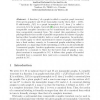Free Online Productivity Tools
i2Speak
i2Symbol
i2OCR
iTex2Img
iWeb2Print
iWeb2Shot
i2Type
iPdf2Split
iPdf2Merge
i2Bopomofo
i2Arabic
i2Style
i2Image
i2PDF
iLatex2Rtf
Sci2ools
CSR
2008
Springer
2008
Springer
From Invariants to Canonization in Parallel
A function f of a graph is called a complete graph invariant if two given graphs G and H are isomorphic exactly when f(G) = f(H). If additionally, f(G) is a graph isomorphic to G, then f is called a canonical form for graphs. Gurevich [9] proves that any polynomial-time computable complete invariant can be transformed into a polynomialtime computable canonical form. We extend this equivalence to the polylogarithmic-time model of parallel computation for classes of graphs having either bounded rigidity index or small separators. In particular, our results apply to three representative classes of graphs embeddable into a fixed surface, namely, to 3-connected graphs admitting either a polyhedral or a large-edge-width embedding as well as to all embeddable 5-connected graphs. Another application covers graphs with treewidth bounded by a constant k. Since for the latter class of graphs a complete invariant is computable in NC, it follows that graphs of bounded treewidth have a canonical for...
| Added | 19 Oct 2010 |
| Updated | 19 Oct 2010 |
| Type | Conference |
| Year | 2008 |
| Where | CSR |
| Authors | Johannes Köbler, Oleg Verbitsky |
Comments (0)

